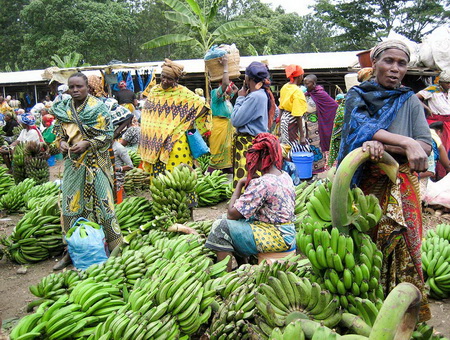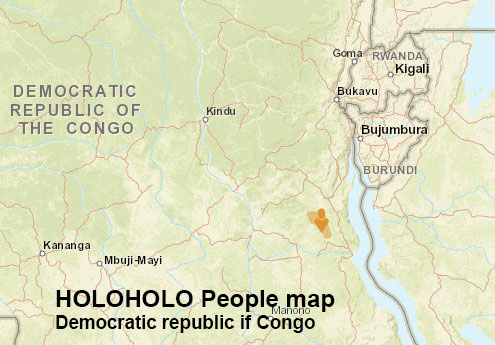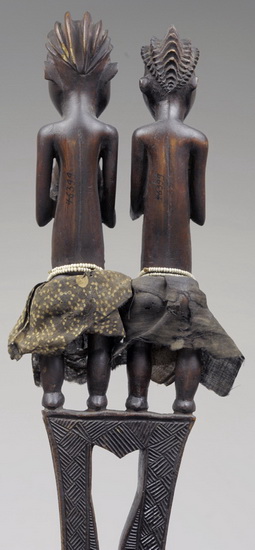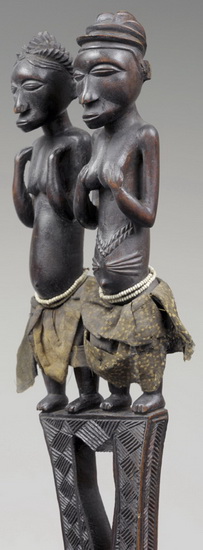

The Holoholo people (also Horohoro or Kalanga) are an ethnic group that live around Kalemie city on Lake Tanganyika in the present-day Tanganyika Province of the Democratic Republic of the Congo, and on the opposite shore of the lake in Tanzania. Language. As of 2002, there were about 15,500 speakers of the Holoholo language. The name "Holoholo" was given to them by the Belgians. It comes from the sound of their greeting, which outsiders found comical. The alternative name "Kalanga" simply means people who were there before the current population. |
 |
The Holoholo are a matrilineal people. They are descendants of Baguha people who fled from the Luba Empire when it was expanding eastward in the 18th century, settling around Kalemie where the Lukuga River leaves the lake. During the period of Luba dominance that followed the eastward expansion under Luba king Ilunga Sungu around 1800, bambudye secret societies were introduced among the Holoholo and other peoples, propagating oral traditions of the Luba royal family. The Holoholo adopted and adapted the Luba genesis myth, in which they believed there was a mountain called Ilunga Sungu on the west side of the Lualaba towards the Luba heartland, This refers to the location of the court of Ilunga Sungu at Katende.
The 1935 book Les peuplades du Congo belge shows the Holoholo living on both sides of the Lukuga. They became middlemen in the Arab and African slave trade. With the suppression of this trade, the economy collapsed and disease and local warfare decimated the population. Today the economy is mostly agricultural-based on sorghum, maize, peanuts, and beans. Fish are caught with nets, dried and sold locally, the main source of cash in the area. Sorghum is used to make beer.
The Holoholo who live in Tanzania around Kungwe Mountain has a tradition that their ancestors came from the Congo side by means of a long island that continued Kungwe Mountain into the lake. The lake level is highly variable, so it is conceivable that they crossed at a time when it was much lower than today when part of the ridge separating the northern and southern basins of the lake would have been exposed.
Thousands of Holoholo had settled along the Tanganyikan side of the lake by 1915, having sailed over in canoes. A census in 1948 counted 4,410 Holoholo in Tanganyika.
In 1987 the Holoholo people had an estimated population of 12,500 in Tanzania. They traditionally lived in the Mahale Mountains on the east shore of the lake opposite Kalemie. However, they were expelled from this area after 1979 to make way for the Mahale Mountains National Park created in 1985.
Holoholo economy during the height of late 19th century expansion was directly related to the eastern African slave trade. The Holoholo were employed by the Arabs to guard the lakeside ports and warehouses where gold and ivory were stored to await shipment across the lake. Today the region is primarily agricultural. Men and women work together to grow sorghum, maize, peanuts, and beans for local consumption. The sorghum is used to brew large quantities of local beer. Net fishing is also carried out on the lake. Fish are dried and sold in local markets to generate minimal cash flow in the region.
The Holoholo never existed as a discrete ethnic group and as a result did not acknowledge allegiance to one particular political power. They were a small conglomeration of diverse peoples who shared a common language used primarily to expedite regional trading. Individual villages and families usually recognized a local leader, and theirs was an abbreviated feudal system. Very little political structure remains in the region today that is reflective of the Holoholo influence.
The supreme god is Kabedya Mpungu ("remote in the sky"), and appeals are never made directly to him. Local religious practices center around ancestor worship carried out through offerings made to miniature huts, which are said to house the souls of the muki (spirits). Nature spirits that inhabit rocks, water, and mountains are not appeased by the general population, but their services may be called upon by witch doctors. Two secret societies exist for healers and witch doctors, one each for men and women. Secrecy and witchcraft accusations act as powerful social controls. Poison ordeals were employed to determine whether an accused was actually guilty of witchcraft.
The confluence of ethnic groups that resulted in Holoholo identity is reflected in their art, which incorporates many diverse styles. Elements of Luba and Tabwa styles are both apparent. A few figures attributed to the "master of slit eyes" represent the best known Holoholo art objects in museum collections.




Sources: